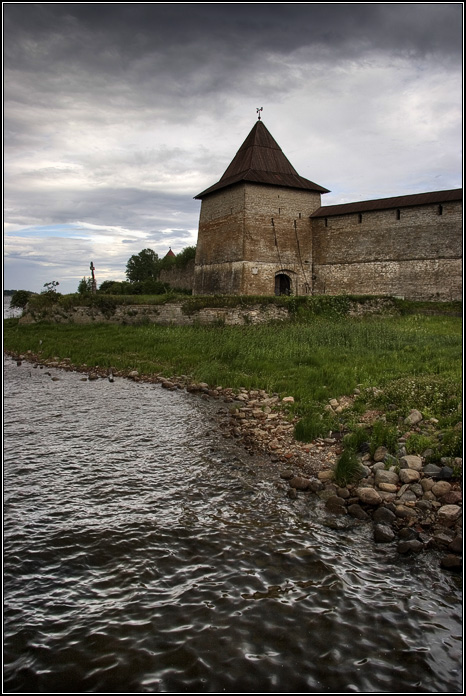Oreshek fortress. Souverain tower.
Built as a fortress named Oreshek ("Nutlet") by the Novgorod Republic in 1300, it had a key strategic position guarding Novgorod and access to the Baltic Sea. The fortress is situated on Orekhovets Island, whose name refers to nuts in Swedish, Finnish (Pähkinäsaari, "Nut Island"), and Russian.
In 1323, after numerous Russo-Swedish conflicts, a peace treaty was signed in Orekhovets between Sweden and the Novgorod Republic (Treaty of Nöteborg), which was the first agreement on the border between Eastern and Western Christianity, running through present-day Finland.
The fort was captured by Sweden in 1611 during the Ingrian War. As part of the Swedish Empire, the fortress was known as Nöteborg ("Nut-fortress") in Swedish or Pähkinälinna in Finnish, and became the center of the north-Ingrian Nöteborg county (slottslän).
Inside the fortressIn 1702, during the Great Northern War, the fortress was taken by Russians under Peter the Great in an amphibious assault. It was then given its current name, Shlisselburg, a transcription of Schlüsselburg. The name, meaning "Key-fortress" in German, refers to Peter's perception of the fortress as the "key to Ingria".
During the times of Imperial Russia, the fortress was used as a notorious political prison; among its famous prisoners were Wilhelm Küchelbecher, Mikhail Bakunin and, for 38 years, Walerian Lukasinski. Ivan VI of Russia was murdered in the fortress in 1764, and Lenin's brother, Aleksandr Ulyanov, was hanged there too.
Interior of the dungeon.Out of ten towers, the fortress retains only six (five Russian and one Swedish). The remains of a church inside the fortress were transformed into a memorial to the fortress's defenders. There is also a museum of political prisons of the Russian Empire, and a small collection of World War II artillery.










Kombizz Kashani 13/07/2007 18:49
well composed and colorful landscapeWayne Tsipouras 12/07/2007 23:43
Great story and expressive image.One wonders what stories these walls would tell if they could only speak.
Splendid.
-Wayne
Kristianto Wibowo 11/07/2007 10:38
I love your composition and angle. Thanks for the information.